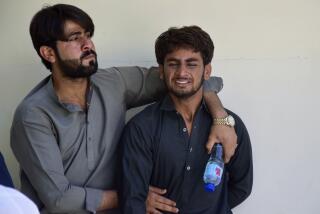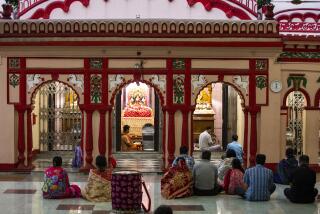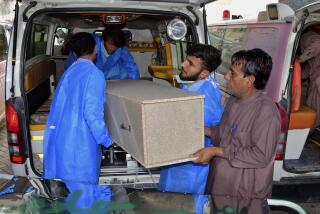Massacre on a Bus: A Sign of Bhutto’s Slipping Grip on Power, Critics Say : Pakistan: The attack left 27 dead, 41 hurt. It was the latest episode in a vicious cycle of violence that has created the prime minister’s worst crisis yet.
- Share via
KARACHI, Pakistan — Nearly 100 weary commuters were packed into the No. 17 bus in Karachi when it became the latest target in one of the world’s bloodiest undeclared urban wars.
A few minutes after 7 p.m. last Thursday, four hooded men in a taxi forced the bus to stop and opened fire with AK-47 assault rifles, circling the vehicle and raking it with hundreds of rounds. Three minutes later, while passengers wailed Koranic prayers and screamed for help, 27 people lay dead and 41 were wounded.
Among the victims were women, children, tailors, bakers and other tradesmen. And even this shellshocked city has been left reeling with horror at the massacre.
The attack, attributed to nationalists in the province of Sind, was the latest episode in a vicious cycle of Sindi violence that has presented Prime Minister Benazir Bhutto with her worst crisis yet.
For the first time since she took office in 1988, Bhutto, who had fought for years against a harsh martial-law regime, has been forced to call out the army to restore order in her home province.
An infantry division of nearly 20,000 men has set up 300 sandbagged machine-gun emplacements at locations throughout the city. Gen. Mirza Aslam Beg, the army chief of staff, vowed to use “an iron hand” to end the conflict, which has left hundreds dead this year alone.
For many critics, Bhutto’s decision to use the army is an admission of defeat for her government and a strong signal that the 36-year-old prime minister’s grip on power may be weakening.
Karachi and Sind are the foundation of Bhutto’s Pakistan People’s Party, and her people have held the reins of power throughout the province during a time when law and order have all but disappeared.
Critics say Bhutto’s policies have favored the province’s Sindi-speaking natives over Urdu-speaking Indian migrants who are the backbone of a growing, urban middle class. They also charge that she is responsible for worsening the polarization of the two heavily armed communities.
Worse, independent analysts say, calling out the army is only a stopgap measure, and in any case the fighting between the Sindis and the Indian migrants, known as Mohajirs, is only one aspect of the violence sweeping this city of 10 million. They say that Karachi, the financial capital of Pakistan, is virtually run by international drug syndicates, local bandit mafias and sniper gangs who are as well-armed as Gen. Beg’s army.
“This place has become a jungle,” said Farooq Sumar, a Karachi industrialist who has helped organize businessmen nationwide in the Movement for the Restoration of Peace in Pakistan.
“There are arsenals of weapons in the university campuses. Everyone has machine guns and rocket launchers. What we have is a situation where the two problems of arms and ethnic unrest are feeding each other. If there was just ethnic trouble without all these arms, the problem would be less. The bottom line is that people can’t talk to each other when everyone has arms in their hands.”
Karachi has been prone to violence for nearly a decade, since it became the hub for heroin exports leaving the frontier area between Afghanistan and Pakistan and for arms supplied by the CIA to guerrillas in Afghanistan.
But diplomats here say the violence has escalated sharply in the past few weeks. Last week’s toll: nearly 300 dead.
“They seem to be in a downward spiral,” said one diplomat who requested anonymity. “Each episode is worse than previous episodes.”
On the last day of May, the day the No. 17 bus was shot up, other gunmen opened fire in a courtroom of the Karachi High Court, killing a prominent lawyer and two clerks. Over the weekend, three journalists were shot to death in provincial towns. According to army sources, radical Sind groups have targeted 25 reporters for Urdu-speaking newspapers. In another incident, a national senator was shot by a sniper while touring Karachi’s worst-hit neighborhoods.
Other targets include businessmen and industrialists, some killed and others abducted. Many have fled the province and taken sanctuary elsewhere in Pakistan or abroad.
For Farooq Sumar and many Karachi intellectuals, the “anarchic state of affairs” they referred to in a petition hand-delivered to Bhutto is rooted in a political paradox.
Bhutto, an international symbol of democracy, has restored free elections, freedom of the press, an open court system and other trappings of democracy since her election in 1988. But in doing so she relied on the support of feudal rural lords who now serve in Parliament as members of her party.
“Democracy is supposed to be the death knell for feudalism, but here we’re trying to make them coexist,” Farooq said. “It has become a mockery of democracy.”
The feudal lords are the backbone of the Sind nationalist movement, and this has brought on criticism that the Bhutto government and the police are siding with the Sindis.
The Indian migrants, represented in the fighting by the heavily armed and increasingly militant Mohajir Freedom Movement, are in the majority in Karachi and other urban areas of Sind.
They have 14 seats in Parliament, and they had formed an alliance with Bhutto’s party. But soon after the election the alliance was broken, and the Mohajirs have felt ever since that they are being persecuted by the Bhutto government and the police.
The Mohajirs look to the army for help, and thousands of them took to the streets to cheer when the army was called out. Many carried portraits of the late dictator, Gen. Zia ul-Haq, who strengthened the Mohajir movement as a foil against the largely pro-Bhutto Sindi nationalists.
Increasingly, though, the rift between the two groups is spreading into the police and army, leading many analysts to fear that martial law will be reimposed in the near future.
Military men make no secret of their disdain for the police, who are widely regarded as corrupt and given to brutal treatment. They blame the police for the latest spiral of violence, which began with a series of killings in Hyderabad. Police opened fire on Mohajirs trying to protect four alleged bandits. Nearly 100 civilians were killed.
More to Read
Sign up for Essential California
The most important California stories and recommendations in your inbox every morning.
You may occasionally receive promotional content from the Los Angeles Times.










